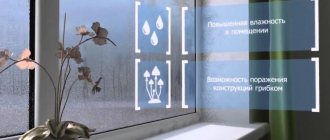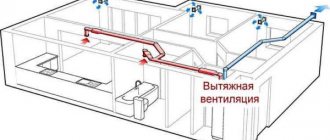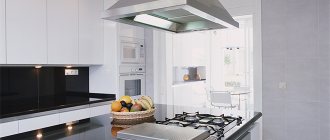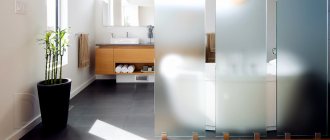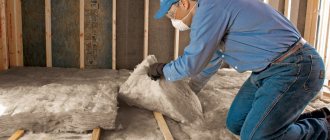Stuffiness - an unpleasant, but at the same time common phenomenon for urban housing owners. For what reasons does the room become stuffy? Why doesn't ventilation help in the summer heat? What to do if it’s stuffy in the apartment?
Everything is relative. If you compare a modern apartment and a rustic log house with the “conveniences” on the street, the first may seem like a real communal paradise. However, the owner of a log house could hardly spend at least a week in an ordinary 9-story panel apartment. He simply wouldn’t be able to breathe in it, there wouldn’t be enough fresh and clean air.
The habit of city dwellers to endure stuffiness can create many problems. It leads to constant fatigue, long periods of falling asleep, poor sleep and headaches in the morning.
There are several reasons why stuffiness is created in the house - both in winter and in summer.
Have problems with the thyroid gland
If a person is constantly tired and feels hot all the time, it may be due to hyperthyroidism, a syndrome in which the thyroid gland produces more thyroxine and triiodothyronine than the body needs. Excess hormones lead not only to overheating, but also to severe weight gain, tachycardia, and menstrual irregularities.
Read also: The dog is aggressive towards other dogs
Problems related to the thyroid gland should be diagnosed by an endocrinologist. He will prescribe the necessary tests, help adjust your diet, which will remove excess stress from the nervous and cardiovascular systems and, as a result, restore hormonal balance, and also select a treatment regimen.
Consequences of constant stuffiness
If the carbon dioxide content in the atmosphere of a house constantly exceeds the norm, then negative consequences cannot be avoided. It is impossible to get a full night's sleep in such a room - after waking up, a person may experience a headache, and his performance will decrease. Dizziness is possible.
If the house is very stuffy, and the situation does not change for months, then an exacerbation of chronic diseases and shortness of breath may occur. High CO2 content in the air contributes to acidosis - acidification of the blood, which increases blood pressure, increases heart rate and worsens blood circulation. An excess of carbon dioxide negatively affects the development of the fetus in pregnant women, leading to poor appetite, apathy and poor health in children.
In order not to lead yourself to a serious deterioration in health, you need to reduce stuffiness by identifying its main cause and taking the necessary measures.
How to deal with stuffiness
The answer is simple - provide a flow of fresh air. Cleaning it is also important: it is desirable that dust, soot and allergens do not enter the room.
The solution to the problem is to install ventilation that purifies the air. An example of such ventilation is supply and exhaust ventilation.
Her work is similar to human breathing. First, the system inhales: it takes air from the street. The air passes through filters that trap dust, dirt and allergens. Exhaust system: the hood takes air from the room and removes it outside. The duration of each inhalation and exhalation is 40 seconds. This way, fresh, purified air constantly enters the room, and carbon dioxide comes out.
Using a smart hood, you will not catch a cold due to the influx of cold air in winter and will not overheat due to hot air in summer, since the system cools warm air and heats cold air. In both cases, fresh air enters the room without the need to open a window and introduce dust, noise and unpleasant odors.
Read also: How to find it in Google's cache?
Why is it stuffy in the apartment?
It must be said that the feeling of stuffiness can be subjective. In extreme heat, the body works under strain due to problems with heat removal, so there is a feeling of lack of air. Excessive humidity can also create this feeling, but it becomes truly stuffy when the proportions of oxygen and carbon dioxide in the air are disturbed.
The main reason why stuffiness occurs in the apartment is ourselves. An adult consumes up to 1,500 liters of air in one hour and exhales up to 60 liters of carbon dioxide into the atmosphere of the room. If all windows and doors are closed in a medium-sized room, then in just one hour of a person’s stay in it, it will increase the carbon dioxide content to 1830 mg/m3, which is 2.5 times higher than the permissible norm.
In addition to the person himself, sources of carbon dioxide can be pets, a gas stove and indoor plants.
Fact. For normal well-being and proper rest, the norm of CO2 content in the air should not exceed 732 mg/m3. For comparison, in a pine forest the CO2 level is approximately 640 mg/m3.
In a house where there is nothing obstructing the flow of outside air, there will be no stuffiness. Unfortunately, this cannot be said about the vast majority of city apartments. The real problem with a typical housing stock is a poorly functioning exhaust hood, when the “exhaust” air is almost not forced out into the exhaust duct of the home ventilation.
Stuffy in winter. Does your hood work great, but the room is still stuffy? This problem is typical in winter, when the windows are tightly closed and the room is rarely ventilated. The fact is that plastic windows, for all their advantages, have one important drawback - they are practically airtight. They protect heat, but at the same time, in the closed position, they do not allow air to pass through at all.
The only source of fresh air in this case is an open window. Most of the time the windows are closed. There is no influx, therefore there is no air exchange: this is how stuffiness is created. For proper ventilation, you need to keep the windows completely open for 1-1.5 hours. In cold weather this is problematic - the house will freeze, and it won’t take long to get sick.
Summer stuffiness. The heat in summer itself is difficult to bear in an enclosed space. An excess of carbon dioxide only intensifies this feeling, and ventilation no longer helps. Why is it stuffy in the apartment with the windows open? In hot weather, due to high atmospheric pressure, air exchange stops - instead of refreshing coolness, hot air flows into the room through the windows.
Cooling the bed
Often, due to the heat, we experience problems sleeping. In a stuffy room, it becomes worse to fall asleep and the sleep itself becomes restless.
- Lay bed linen from natural materials. Cotton, linen and silk retain coolness longer and cool the skin.
- Avoid pajamas made from low-quality materials that do not allow air to pass through and create a greenhouse effect on the skin.
- Placing bedding in the refrigerator before you go to bed will help your body fall asleep more comfortably.
Why air conditioning doesn't help?
The air conditioner cools the air in the room. It does not draw in air from the street and does not release it outside.
Using air conditioning is even dangerous: it creates a false sense of a comfortable atmosphere in the room. Cool air makes you think the room is fresh when in fact it is not.
If you sit indoors for a long time with the air conditioner running, carbon dioxide will accumulate and your health will worsen.
What are the benefits of OXY supply ventilation?
OXY allows you to effectively combat stuffiness by forcing fresh air into the house and thereby ensuring stable air exchange. With such a device you can regulate the intensity of the inflow yourself.
Thousands of OXY customers have chosen it for three reasons:
- No stuffiness even with the windows closed . You can forget about the constant dust on the windowsill, screams under the window and drafts;
- Street air is purified by filters. A set of filters provides deep air purification from various contaminants - smoke, burning, exhaust, foreign odors and allergens;
- Ease of use. It is controlled from a panel on the body or from a remote control, there is manual speed control, air heating, and can work in passive mode (without electricity).
In conclusion, it is worth mentioning another important characteristic of this supply ventilation – its price. Unlike foreign analogues, the price of OXY does not “bite”. In the minimum configuration, the device costs 3990 rubles.
Let's sum it up
To keep the room from being stuffy, use new generation ventilation. It provides a flow of fresh air, but does not let dirt and allergens in. This way the room will be clean, and allergy sufferers will not suffer from dust and pollen.
Also, a modern hood releases carbon dioxide into the street, so it fights the stuffiness that appears due to excess carbon dioxide in the room.
To order supply and exhaust ventilation VAKIO or find out more about it, call 8 800 707 0332, order a call or write to us
How to make ventilation indoors below ground level
If even a small part of the basement is above ground level, an air intake opening must be made in the basement. Exhaust gases are discharged through the manifold ventilation shaft. If there is no ventilation shaft, the exhaust air is directed through the wall opposite the suction opening. Grilles are installed on ventilation openings to protect against rodents, precipitation and dirt.
If the basement is completely underground, then the supply and exhaust air ducts pass through the basement.
Fans are installed inside air ducts for more efficient air exchange.
Hyperhidrosis has appeared
These are problems with sweating, in which a person feels sweaty and hot even in a cool room.
Hyperhidrosis can occur while taking antidepressants, tuberculosis, damage to the nervous system, and endocrine diseases. Excessive sweating is treated by a dermatologist, and before consulting with him, you should visit a neurologist with an endocrinologist. Having ruled out neuropathies and diseases such as diabetes, doctors will select measures that will help cope with excessive sweating and fever. Sometimes changes in lifestyle and diet are enough for this; some people are prescribed Botox injections into the armpits, feet or palms.
Forced ventilation
Forced air circulation is achieved through the installation and operation of special equipment. It can be of different varieties, but the essence is the same - each device has a fan, the blades of which take air masses and send them along the route - into the ventilation duct, from where they then go outside.
Most devices connect directly to the vents. When it comes to the kitchen, you can most often find a device called a hood. It is usually installed above the stove. Thus, steam and grease-contaminated air are sent directly into the channel without spreading throughout the room. Naturally, for this to happen, the hood must be turned on.
As for the toilet, bathroom or combined bathroom, a fan is usually installed here. It can be axial wall or axial channel. The first is mounted on the wall at the entrance to the ventilation, the second - directly into the duct. Most often, it is wall-mounted equipment that is used, since it is much easier to install and copes with its responsibilities no worse than its ducted counterpart.
Any forced equipment can be presented in both the simplest and advanced modifications. For example, devices are often equipped with a timer that automatically turns off after a specified period of time. This way, you don't have to constantly remember to turn off the kitchen hood when it's running. And electricity is being saved little by little.
But all of these devices are good in certain situations - that is, when there are problems with the composition of the air that need to be corrected quickly. At night, this approach is usually not used. Firstly, forced exhaust equipment is often manually controlled, and you won’t constantly wake up to turn the device on or off.
Secondly, most varieties have a fairly high noise level. This definitely interferes with healthy sleep - not only yours, but also your neighbor's. Therefore, at night it is important to arrange normal air exchange in other ways. And do this at least in the bedroom, since it is in this room that air circulation is necessary at a given time.
Which house has the freshest air?
I do not believe that the technology by which the house was built, the material of the walls, the presence of vapor barriers, and finishing materials somehow affect the air staleness in the room and the difficulty of our breathing. What do you need for stuffiness? We've already figured this out, it seems. You need high temperature, unnatural humidity, and the presence of strong and often unpleasant odors. You may also need to eat a lot of food before bed, drink a lot of alcohol, or have general health problems, including mental problems. Regarding mental problems, I would like to clarify. This may be simple schizophrenia, but what I mean is that stress and anxiety affect our body in the same way as alcohol with rich food. Our body enters a working state with an increase in body temperature, increased heart rate and breathing. Although, I must admit, schizophrenia also happens in a mild form. This is when a person slept well and says - all because your wallpaper is not vinyl. And they are actually vinyl. The person just didn’t understand, and slept peacefully all night and didn’t feel stuffy.
Let's say we have walls made of breathable materials. This means they absorb excess moisture from the air when there is a lot of it, and give it back when there is little of it. But they give it back already odorized (that is, with a smell)! If it is a wooden house, then the air will have a corresponding smell. If it’s a brick, then it’s the same. So, when the walls release moisture into the air, the latter can become stale. The humidity will rise and the smells will increase - two main conditions for stuffiness.
Let us now assume that our house is not breathing. Does this mean that we always breathe the same air? Well, yes. Just like in a house built using any other technology. But only if we don’t open the windows. We opened the window and the air immediately became fresher. Excuse me, but I have serious reasons to believe that it is easier to replace the air in a house with non-breathing walls than in a house with breathing ones. This means that it will be easier to create freshness in a tiled room than in a room decorated exclusively with breathable materials. At least nothing will be absorbed into the walls and there will be no smell. And the smell, I repeat, is one of the main conditions of stuffiness. Theoretically, we can dry out the air in a house with non-breathable walls. But in the same way you can dry out the air in a breathing house. In the end, what matters is not what the house is built from, but what the air is like outside.
How to cool an apartment: unusual ways
Many people are used to pointing the turned on fan towards themselves, but few people know that this is wrong. It is necessary that it blows cold air onto the furniture, and that, in turn, can absorb the heat emanating from other interior items. To keep it cooler, you can place bottles of ice and cold water in front of the fan.
You can use other options that you don’t often see in normal times:
- Place buckwheat in the pillow - experts say that such an unusual method allows it to retain heat less well;
- Do not sleep on the bed - you can put the mattress on the floor and immerse yourself in the arms of Morpheus, since it is much cooler downstairs;
- Don't drink cold water - Many people try to cool themselves down by drinking cold water. This is incorrect, as the body will quickly heat up as it tries to replenish lost heat. Therefore, no matter how surprising it may be, it is better to drink tea.
Subject:
- heat
- Lifehacks
How much air do you need to provide?
It is important to calculate the amount of air needed for the room. The calculation should be based on the following factors:
- how many people and how often will they be in the room;
- what exactly will the room be used for (if for relaxation and quiet entertainment, then you can get by with a reserve of 30 m³/h per person, if heavy physical work is performed, 60);
- what conditions are specific to a given room (for example, if it is a basement, the likelihood of moisture getting inside is greater than in an above-ground room);
- whether harmful substances will be released (for example, if a windowless room is used as a workshop where painting work will be carried out).
In most cases, a simple calculation can be made. This means about 30 cubic meters of air per hour per person indoors. This is a minimum value, but in general it is advisable to raise it to 32-35 cubic meters of air per hour.

